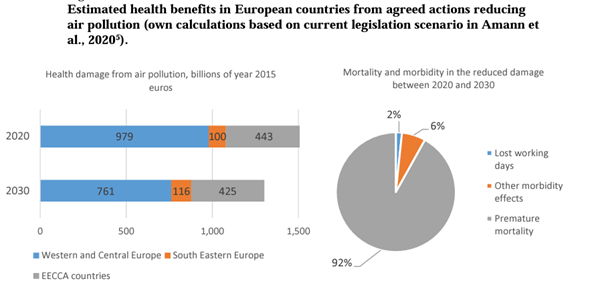
New research on the Costs of Inaction on air pollution reveals that in nearly half (26) of 56 countries in the Pan-European region and North America, the current monetary damage cost to health, ecosystems and the economy due to ambient air pollution corresponds to over 5 per cent of GDP. In at least 6 countries, the damage is more than 10 per cent of GDP. The largest part of the damage cost consists of reduced life expectancy, followed by morbidity costs (e.g., hospital admittance, sick leave, medicine costs), and damage to ecosystems. To compare, the average cost of an optimal air pollution strategy is estimated to be 0.01–0.02 per cent of GDP. This means that in most cases, the cost of implementing available pollution reduction measures is far lower than the cost of damages.
In the European Union, benefits of policy scenarios for the EU Clean Air Package are estimated at about 10–40 times higher than costs. Additional policy measures in the EU-27 on top of the current ambition levels would lead to benefits that are estimated to be approximately 25 times higher than costs. In the US, welfare benefits from the Clean Air Act are estimated to be more than 30 times higher than implementation costs, according to the US Environmental Protection Agency.
“Countries need to increase their air pollution emission reduction efforts across all sectors and sustain their efforts over the next decades. With the cost of action being a fraction of that of inaction, I invite the finance ministers of the region, and beyond, to take a close look at this report and incorporate its findings into their fiscal plans. Capitalising on international cooperation under the Air Convention and fully implementing its practical guidance can deliver results for health, ecosystems, the climate and the economy, saving countries billions of dollars.” says Olga Algayerova, Executive Secretary of UNECE.
“The numbers are crystal clear. Investments in air pollution abatement measures pay off. Applying the best available techniques will benefit air quality, climate, biodiversity and food production, and save energy and natural resources. Integrated approaches to environmental policymaking are needed more than ever, which is a key lesson from over 40 years of successful international cooperation under the UNECE Air Convention” comments Anna Engleryd, outgoing Chair of the Executive Body for the Convention.
Clean air policies will lead to large benefits, but forecast for future damage remains uneven
Monetary damage due to air pollution in the region up to 2030 is expected to be reduced by at least 14 per cent compared to 2020, supported by the implementation of existing national emission reduction obligations and current emission limit values set in the protocols to the Convention. Expected damage reduction will (as a percentage of GDP) be higher in the Western part of the region since this region is expected to implement stricter emission reductions.
In Western and Central Europe, the total annual benefits (avoided damage) of air pollution reduction measures in 2030 are estimated at € 218 billion (approximately 0.9 per cent of current GDP, on average), compared to 2020. However, total annual damage will still account to €760 billion in 2030, just short of the GDP of Switzerland. In all, 2 per cent of the gained benefits are due to an increase in labour productivity, 6 per cent to other morbidity effects, and 92 per cent to avoided premature mortality.

In countries in Eastern Europe, total health damage is expected to fall by €17.5 billion (4 per cent of total damage costs and approximately 0.4 per cent of current GDP) between 2020 and 2030 – yet, annual damage will still account to €425 billion in 2030. In countries in the Caucasus and in Central Asia, costs of mortality attributable to air pollution varied from approximately €9.8 billion in Armenia to over €70 billion in Uzbekistan in 2010.
In South-Eastern Europe, health damage from ambient air pollution is expected to increase from €100 billion in 2020 to €116 billion in 2030 (17 per cent increase) if no additional action is taken. Health damage attributable to air pollution constitutes 4–15 per cent of the countries’ GDP in this region.
In the US and Canada, air pollution is calculated to result in a GDP decrease of approximately 0.1 per cent in 2060 compared to a non-polluted situation due to reduced labour productivity. Costs of morbidity per capita in North America in 2060 are projected to be around €100–€150 per year.
In addition to the health damages, agricultural production also shows losses due to air pollution. Production of crops and wood in Europe is reduced by up to 15 per cent due to the harmful effects of ground-level ozone, depending on species sensitivity; annual losses for wheat production are estimated to be over €46 billion. In the USA, by 2060, agricultural production will fall by 4.9 per cent due to air pollution.
Existing measures and regional cooperation already proven to slash costs
Air pollution reduction measures, supported by countries’ binding emission reduction commitments under the Air Convention, are shown to already save billions of dollars of damages each year.
For example, compliance with the EU National Emission reduction Commitments Directive for NH3 emissions, which mirrors the commitments in the Convention’s Gothenburg Protocol, is estimated to have resulted in €14.6 billion in socioeconomic benefits from avoided premature deaths in the European Union-28 in 2016. Estimates for the Netherlands show that, in 2015, the avoided monetary health damage amounted to €35 billion per year, compared to a “no action 1980–2015” scenario. Of this figure, 53 per cent is attributable to emission reductions in the Netherlands, while almost half is due to emission reductions in other European countries, including Belgium, France, Germany and the United Kingdom of Great Britain and Northern Ireland. This highlights the critical importance of the broad regional action for clean air facilitated through the Convention.
In North America, the Clean Air Act of the United States of America was estimated to result in annual benefits of €2 trillion – this is from avoided premature deaths, morbidity, damage to crops and materials and recreational values. Of this figure, €10 billion is benefits in the agricultural sector, and €20 billion from reduced medical expenditures. The country’s GDP growth due to the health effects of Clean Air Act implementation is estimated at 0.02 per cent, according to the US Environmental Protection Agency.
Additional and integrated measures for clean air and climate pay off
Even greater benefits can be achieved if air pollution reduction measures are effectively combined with policies and measures targeting greenhouse gas emissions, such as fuel transitions or behavioural changes reducing energy demand.
Of the European Union damage costs expected to remain in 2030, 21 per cent could be removed through additional policy actions. If these policy actions are combined with climate measures, the damage reduction in 2050 could reach 26 per cent.
Recent analysis in the second Clean Air Outlook shows that within the EU-27, implementation of measures in accordance with National Air Pollution Control Programmes could result in additional health benefits of about €8 billion–€43 billion annually. Additionally, EU countries could gain about €305 million–€900 million annually from reduced damage to materials, crops, forests and natural ecosystems. These are benefits achieved without excessive costs. If all technically feasible measures were to be applied irrespective of costs, annual health benefits would reach €153 billion-€205 billion in 2050, accompanied by €2.2 billion-€5 billion in non-health benefits.
For example, In the EU transport sector, a faster uptake of zero emitting vehicles and a ban on pre-Euro 6 vehicles in all major cities would result in welfare benefits corresponding to €5.2 billion per year in 2030 due to improved health, reduced mortality, better crop yields and biodiversity. Making transport policies even more ambitious – ban on pre-Euro 6 vehicles on all roads, road pricing, urban policies to reduce car use in cities – would bring €10.5 billion in benefits.
Health co-benefits from different ambition levels of climate policies show that while current Nationally Determined Contributions (NDCs) would result in €200 billion lower damage in Europe (cumulative over the period 2020–2050), a 2°C target implies €800 billion–€2,100 billion health co-benefits, and with the target of 1.5°C, €2,000 billion–€2,900 billion in health damage can be avoided by climate policy. For the United States of America, health co-benefits are estimated at €500 billion with current NDCs, and up to €1,600 billion with higher ambition levels of climate policy.
Note to editors
This research was done before the invasion of Ukraine by the Russian Federation in February 2022. Hence, this scenario has not been considered in the model calculations.
About the Air Convention
The UNECE Convention on Long-range Transboundary Air Pollution was adopted in 1979. Over the years, it has been extended by eight protocols that identify specific measures to be taken by Parties to cut their emissions of air pollutants. The Convention has 51 Parties, covering North America and almost the entire European continent.

